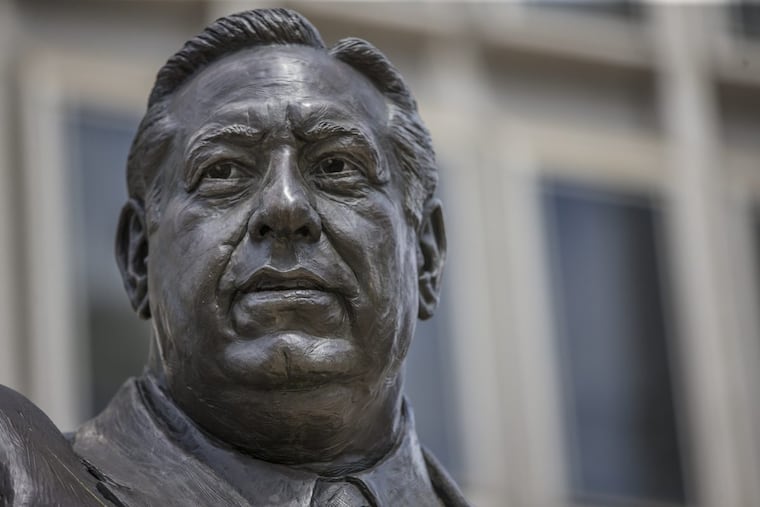Rendell: 'Mistake' to put Rizzo statue at Municipal Services Building
The former governor advocates moving it elsewhere. He had supported the site when he was mayor.

Political leaders are loath to admit mistakes, but former Gov. Ed Rendell now allows it may not have been the best idea to lend his support, when he was mayor of Philadelphia, to the prominent placement of the statue of his predecessor Frank L. Rizzo.
"In retrospect, to put Frank Rizzo in front of the Municipal Services Building," Rendell said, "to single him out from other mayors such as Joe Clark or Richardson Dilworth, was probably a mistake."
The 10-foot-tall, one-ton bronze likeness is at the center of a post-Charlottesville debate: Should the city glorify a man who, to his detractors, oppressed black citizens as police commissioner in the 1960s and became mayor in part by appealing to the racial fears of white Philadelphians? Or are activists demanding the city tear down the statue maligning a good man who supporters believe protected all people from crime and championed the little guy?
"Keep the statue, absolutely don't destroy it, and move it to another location where people who admired him can go and see it," Rendell said. "But, overall, forget about statues. Taking a statue down might make someone feel good for a moment, but it won't help the life of a single Philadelphian."
Rendell becomes perhaps the biggest Southeastern Pennsylvania civic figure to take a stand on the fate of the statue, and his comments contrast with the tightrope-walking of officials such as Mayor Kenney and City Council President Darrell L. Clarke.
Former Mayor W. Wilson Goode Sr., who defeated Rizzo in the 1983 Democratic primary election and the 1987 general election, when Rizzo ran as a Republican, said it was up to Kenney to decide what happens with the statue.
"I don't want to get involved in that discussion," Goode said. "It's something that's on his watch."
Asked whether he was surprised the city was still talking about Rizzo, Goode said: "I think the reason that he's part of the conversation is because of the statue. I don't think he would be part of the conversation otherwise."
The statue was unveiled Jan. 1, 1999, after the Mummers Parade — another institution rooted in South Philadelphia — had made its way around City Hall. Rendell was beginning the last year of his second term as mayor.
Rizzo died in July 1991 during a comeback campaign for mayor, running as a Republican against Rendell, the Democratic nominee. In 1971, Rizzo, then a Democrat, was elected mayor and served two terms.
The movement to erect the statue started less than eight months after his funeral, as admirers of the Big Bambino began raising money for the tribute.
Kenney said he had concerns about the Rizzo statue when it was being planned while he was a member of City Council. An "unwritten rule" in the city called for the passage of at least a decade before such an honor was bestowed on a late politician, Kenney said.
Such concerns were swept away in the desire among city leaders to honor the larger-than-life mayor. Where to put the sculpture was a controversy for years, starting even before it was struck.
Rizzo's son, former City Councilman Frank Rizzo Jr., helped raise the six figures to pay for the statue, including $25,000 in an auction of his late father's cigars. He first asked to place it at the Municipal Services Building. The city's Art Commission told him to go instead to nearby JFK Plaza, known as LOVE Park.
The Fairmount Park Commission, which controlled JFK Plaza, sent him back to the Art Commission, which approved its placement at the Municipal Services Building.
Rizzo's statue stands about 100 feet away from Government of the People, a modernist sculpture erected in 1976 while Rizzo was mayor and much to his very public consternation. Rizzo, who said the sculpture looked like a dropped "load of plaster," refused to pay for the installation. Private benefactors raised the money.
On Tuesday, Kenney said the city's Arts Commission would decide what to do with the Rizzo statue, although the chairman said the commission would not take up the issue until October.